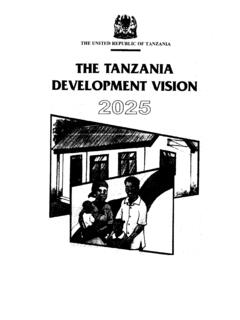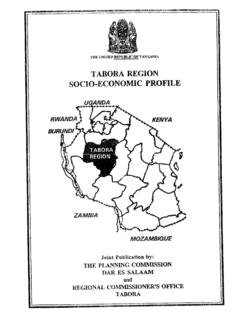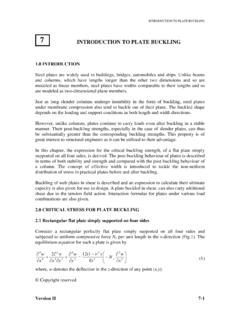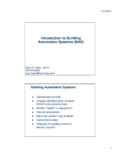Transcription of Agriculture Sector in Tanzania 1 Introduction - Tzonline
1 Implication of the 2006/2007 Budget on the Development of the Agriculture Sector in Tanzania 1 Introduction Tanzania has substantial potentials to achieve faster and diversified economic growth necessary to raise welfare of her people. But the country is experiencing development problems. The economy is characterised by a large share of agricultural goods, predominance of primary exports, low degree of industrialisation and of economic diversification, high population growth rate, and high level of indebtedness. These problems are manifested in poverty as indicated by low income per capita, hunger, diseases, and low life expectancy. Escaping from these economic hooks and creating sustainable development has been a dream of the government since independence.
2 However, so far little has been achieved towards this goal - poverty, especially in the rural areas is still alive and biting. Although increased industrialisation and urbanisation are all important in the growth and development process, there is explicit consensus among economists that development of Agriculture , which is the largest Sector in the economy, is a necessary starting point. (Johnston and Mellor, 1961;. Kuznets, 1964; Nicholls, 1964). To this, Todaro (1989) adds that without agricultural development, industrial growth either would be stultified, or if it succeeded, would create such severe internal imbalances in the economy that the problems of widespread poverty, and unemployment would become even more pronounced. The importance of Agriculture in the economy could be appreciated by considering its contribution to Gross National Product (GDP) and export earnings.
3 If Agriculture was dropped in the equation, Tanzania 's $ billion of nominal GDP in 2004 would drop to $ billion with consequent drop in per capita income from $ 321 to $ 173. On the other hand, export earnings would drop by 60% with severe impact on the balance of payment. That is why increasing productivity of the farming Sector and assurance of a sufficient flow of food and materials from Agriculture to meet the needs of the population and economic growth should be the major strategy to develop the economy in Tanzania (Table 1). Table 1: Gross Domestic Product (GDP) at Factor Cost by Kind of Economic Activity at Current Prices, Tanzania Mainland Millions of TSh Economic activity 2000 2001 2002 2003 2004. A: Monetary Agriculture 1,690, 1,919, 2,205, 2,508, 2,959, Mining and Quarrying 99, 120, 152, 210, 278, Manufacturing 499, 564, 638, 710, 791, Electricity and water supply 112, 124, 145, 156, 177, Construction 282, 335, 389, 454, 532, Trade restaurants and hotels 823, 926, 1,038, 1,153, 1,319, Transport and communication 328, 361, 404, 451, 509, Financial and business services 382, 421, 494, 564, 637, Public administration and other services 709, 796, 893, 956, 1,044, Less financial services indirectly measured -151, -157, -168, -194, -233, Total Monetary GDP 4,777, 5,414, 6,194, 6,972, 8,015, B.
4 Non-Monetary Agriculture 1,330, 1,486, 1,679, 1,909, 2,252, Construction 61, 69, 80, 91, 105, Own - Occupied dwellings 537, 654, 745, 842, 913, Total Non-Monetary GDP 1,929, 2,209, 2,505, 2,843, 3,271, C: Total GDPfc: (A+B) 6,706, 7,624, 8,699, 9,816, 11,287, Population (millions) D: Per capita nominal GDP. (TSh) Source: Bank of Tanzania (2005). Despite government efforts to develop Agriculture , the Sector is still facing numerous constraints. Exports are lower now than they were in the late 1960s and 1970s (World Bank, 2000), and agricultural productivity is still very low and erratic (Vision 2025, 1999). For example, while a farmer in the European Union (EU) produces enough food for 130 people, in Tanzania one farmer produces enough food for 2 people. As a result food shortage is persistent and sometimes cases of starvation are reported.
5 Food shortage makes the country to import thousands of tones of foodstuffs especially cereals. In this way, the country loses not only foreign exchange that could 2. be used to import industrial inputs but also revenue because the importation is accompanied by tax exemption. Precarious food supply gives rise to consumer price instability in urban areas. Worse still food imported is distributed free of charge or sold at a very low price. The long run multiplier effect of this practice is likely to push out local farm products from the market as producers become discouraged. All these are happening in spite of Tanzania being richly endowed with arable land, and other potentials for agricultural production. Since independence the government of Tanzania has been designing different strategies aimed at putting the agricultural Sector on the right footpath.
6 The history of these is too long to explore in this paper, but one thing is certain . these efforts have not produced significant outcome (impact) for the poor in the farming communities. Successes are reported in the papers. Of recent the government has come up with a chain of strategy papers and policy initiatives embedded in the Tanzania Development Vision 2025 and National Strategy for Growth and Reduction of Poverty (NSGRP), colloquially known as MKUKUTA. With regard to the agricultural Sector some of the relevant policies and strategies include Agriculture and Livestock Policy (1997), Agriculture Sector Development Strategy (ASDS) 2001, Poverty Reduction Strategy Paper (PRSP), Cooperative Development Policy (2002), Rural Development Strategy (RDS). National Food Security Policy (2004) and Agricultural Marketing Policy (2005).
7 Under this framework, the country has witnessed mushrooming projects/programs such as Agriculture Sector Development Programme (ASDP), Participatory Agricultural Development and Empowerment Project (PADEP), Agricultural Marketing Systems Development Program (AMSDP), National Irrigation Master Plan (NIMP) and District Agricultural Sector Investment Project (DASIP) just to mention a few. The Government of Tanzania supposedly recognizes that stronger performance of the agricultural Sector is key in realising intended acceleration in real GDP growth and the needed reduction in poverty. 3. Therefore, government budgets are supposed to align themselves along implementation of the programs outlined above with the aim of achieving Sector growth targets and increasing real annual growth rate for export crops with observable impact in food security and income poverty reduction for the rural poor.
8 The aim of this paper is examine if the 2006/2007 government budget proposes measures that would bring the nation closer to achievement of such goals. 2 The 2006/2007 Government Budget and the Agricultural Sector National budget is the most important economic policy instrument for government. It reflects the government's social and economic policy priorities. No policy or plan can be implemented without funding, and thus the budget is the key to implementation of any government policy. A well prepared budget reflects stability of a government to both collect funds and disperse them effectively. A functioning budget system is vital for formulation of sustainable fiscal policies and facilitates economic growth. This paper discusses implications of the 2006/2007 government budget on the agricultural Sector .
9 The discussion is put under two categories; positive and shortcomings of the budget. Positive aspects in the budget with direct impact on Agriculture : There are a number of aspects in the budget that are pro agricultural development. These are outlined in the foregoing section. (a) Agriculture allocated reasonable share The budget states that the agricultural Sector is allocated a reasonable share of the budget as will be indicated by the fund allocated to the lead Ministries of Agriculture namely Ministry of Agriculture , Food Security and Cooperative, Ministry of Livestock Development and Ministry of Local Governments. Given the importance of the Sector , any increase in expenditure is a welcome move. 4. (b) Financial Services to be Improved The budget is set to improved financial services in the country with a view of increasing access to capital for Agriculture .
10 Lack of credit has been one of the areas constraining development of the Sector . According to the budget, the improvement of financial services will be achieved through: Transformation of the National Investment Bank (TIB) into a development bank capable of providing term financing for production sectors including Agriculture . To this end the capitalisation of the bank will be increased by about 50% (from TSh. billions to TSh. 50 billions). Preparation of procedures for establishing SACCOS of different community-based groups which will be facilitated to access credit from commercial banks and financial institutions located in the regions across the country. Appointment of a special committee (jointly the government and CEOs of all banks) which shall review access and evaluate, among other things, the problems associated with perceived risk in agricultural lending.

















